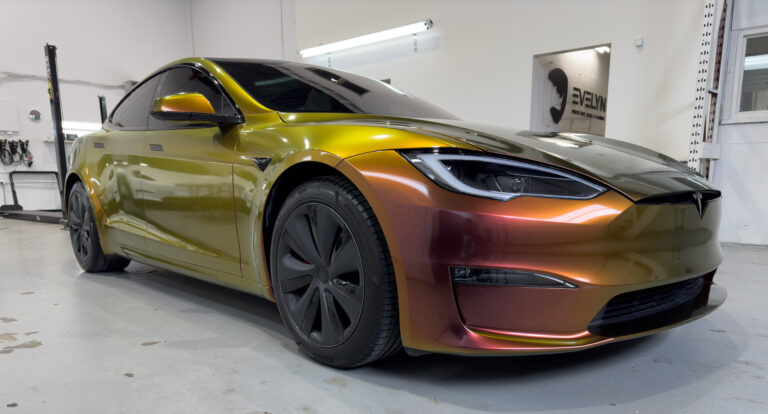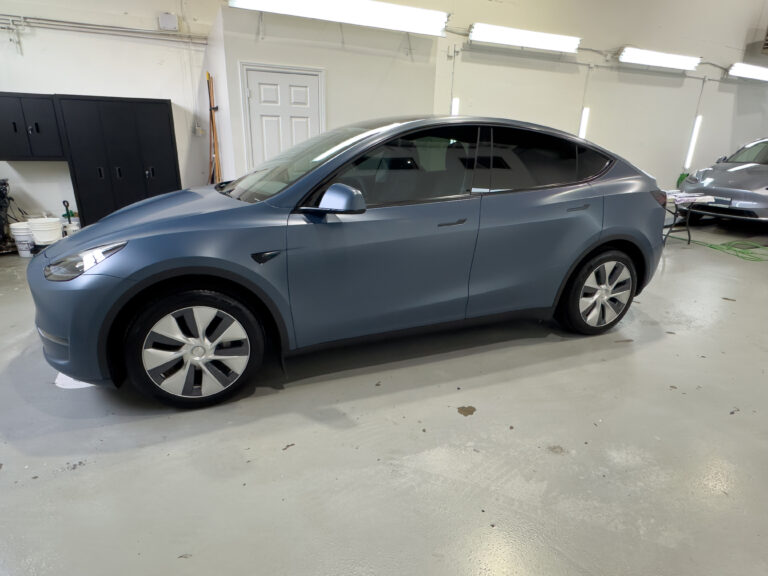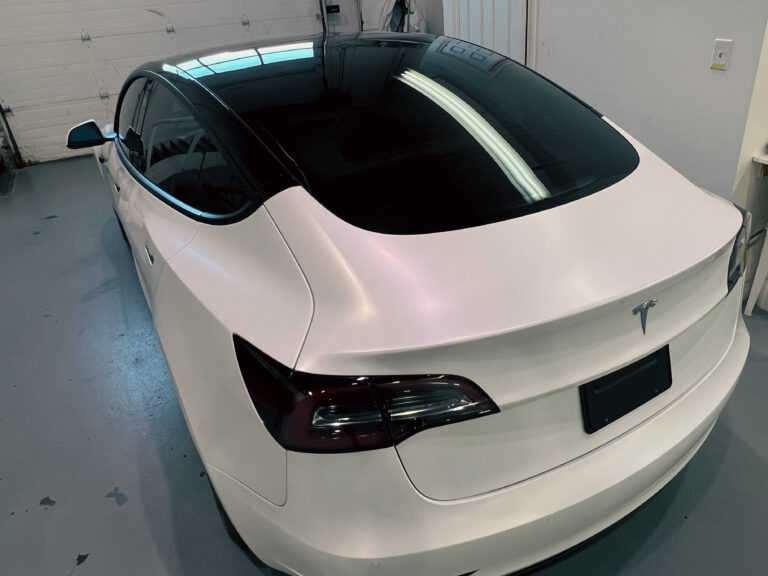The Ultimate Guide to Vinyl Wraps vs. Paint Protection Film: Making the Right Choice
When it comes to enhancing or protecting your car’s appearance, you have a couple of popular options: vinyl wraps and paint protection film (PPF). While they might seem similar at first glance, these two products serve different purposes and have unique benefits. Let’s break it all down, so you can make an informed decision that fits your needs, style, and budget.
What Are Vinyl Wraps and Paint Protection Film?
Vinyl Wraps:
Think of vinyl wraps as a custom suit for your car. These are thin, flexible sheets of vinyl material that come in a variety of colors, finishes, and textures—glossy, matte, satin, chrome, carbon fiber, you name it. They’re primarily used to change the look of your vehicle and can cover the entire car or specific parts like the hood, roof, or mirrors.
Paint Protection Film (PPF):
PPF is more like a transparent shield. Made from thermoplastic urethane, this film is designed to protect your vehicle’s paint from scratches, rock chips, and other minor damage. Traditionally, PPF has been clear and focused on protection, but advancements now allow PPF to be available in colors, glossy, matte, and even color-shifting finishes, offering customization options similar to vinyl wraps. This means you can enjoy both robust protection and an enhanced aesthetic, combining functionality and style.
Key Differences Between Vinyl Wraps and PPF
1. Purpose
- Vinyl Wraps: Primarily aesthetic. If you want a bold new color or a unique design, vinyl wraps are the way to go.
- PPF: Functional protection. It’s all about preserving your car’s original paint, though modern advancements of colored and textured PPF can also provide aesthetic enhancements.
2. Durability
- Vinyl Wraps: Generally last 3 to 5 years, depending on the quality of the material and how well you maintain it. They’re more susceptible to wear and tear than PPF.
- PPF: Typically lasts 5 to 10 years, but improvements in material quality have extended its durability significantly. Many top-tier PPF brands now back their products with warranties up to 15 years, offering unmatched long-term protection and peace of mind. This extended warranty reflects the confidence in the film’s ability to maintain its clarity and protective qualities over time.
3. Thickness
- Vinyl Wraps: Vinyl wraps are relatively thin, typically measuring between 2 to 4 mils (thousandths of an inch). This makes them flexible and ideal for conforming to curves, but provides limited protection against physical damage.
- PPF: Paint protection film is significantly thicker, usually ranging from 6 to 10 mils. This added thickness provides superior resistance to scratches, stone chips, and other physical impacts, making it a robust protective barrier.
4. Appearance
- Vinyl Wraps: Unlimited design possibilities. You can go for solid colors, intricate patterns, or even advertising graphics. However, they don’t protect your paint as effectively as PPF.
- PPF: Traditionally clear, PPF is now available in colored, glossy, matte, and color-shifting finishes, giving you options for customization while maintaining its protective qualities. This evolution bridges the gap between the protective focus of PPF and the aesthetic appeal of vinyl wraps.
5. Application Process
- Vinyl Wraps: Easier to apply and less labor-intensive. A full wrap might take three or five days to complete.
- PPF: Requires precision and expertise, often taking longer to apply, especially if covering the entire vehicle.
Cost Comparison
Let’s talk dollars and cents, because this is often the deciding factor.
Vinyl Wraps:
The cost of a vinyl wrap can range from $3,500 to $5,500 for a full wrap, depending on the material, design complexity, and the size of your vehicle. Partial wraps or simpler designs can cost less. While the upfront cost is lower, wraps need more frequent replacement, especially if exposed to harsh conditions.
Paint Protection Film:
PPF is a pricier investment. For a high-quality full-body application, expect to spend $5,500 to $10,000, or even more for luxury vehicles. However, partial coverage—like just the front bumper, hood, and mirrors—can cost between $1,500 and $2,500. The longer lifespan and protective qualities can make the higher initial cost worth it.
Long-Term Value:
If you’re looking at long-term expenses, vinyl wraps may end up costing more due to their shorter lifespan and the likelihood of reapplication, along with ownership lifecycle. PPF, while more expensive upfront, often proves to be more cost-effective over time due to its durability and ability to prevent costly paint damage. The extended manufacturer warranties offered by some PPF brands further enhance its value.
Are Ceramic Coatings: The Perfect Partner for Wraps and PPF?
Did you know that ceramic coatings can significantly enhance both vinyl wraps and PPF? This innovative liquid polymer forms an additional protective layer, making your investment look better and last longer. Here’s why it’s worth considering:
For Vinyl Wraps:
- Durability Boost: Protects the wrap from harmful UV rays, minimizing fading and cracking.
- Simplified Cleaning: The hydrophobic surface repels water, dirt, and grime, so maintenance is a breeze.
- Eye-Catching Finish: Deepens colors and adds a premium sheen, enhancing the overall look of your vehicle.
For Paint Protection Film:
- Added Defense: Complements PPF’s scratch-resistant properties, guarding against additional wear and tear.
- Extended Lifespan: Keeps the film clear and intact for years longer.
- Effortless Maintenance: Its water-repellent qualities make it easy to maintain a spotless appearance.
Ceramic coatings are a fantastic add-on for anyone looking to elevate their car’s protection and appearance. Whether you’re going for style, functionality, or both, this extra step can make all the difference.
Can You Combine Wraps and PPF?
Absolutely! Combining vinyl wraps and PPF is a fantastic way to get the best of both worlds—style and protection. Imagine using PPF to shield high-impact areas like the front bumper, hood, and mirrors from road debris, while using vinyl wraps to add a splash of color, unique designs, or textures to the rest of your car. This pairing lets you customize your vehicle’s look while ensuring it stays protected where it matters most.
For the ultimate upgrade, add a ceramic coating over both the PPF and vinyl wrap. This creates an extra layer of protection, making maintenance even easier and keeping your car looking flawless for longer. By combining these options, you’re not just customizing—you’re future-proofing your vehicle with style and durability.
Maintenance Tips
- Vinyl Wraps: Hand wash with mild soap and water to avoid scratching or peeling. Use a soft microfiber cloth for drying to prevent streaks and maintain the wrap’s finish. Avoid high-pressure washers or abrasive cleaning tools that could damage the vinyl.
- PPF: Regularly clean the film with pH-neutral soap and water to prevent dirt and grime buildup, especially along the edges. Avoid harsh chemicals that can degrade the film over time. For stubborn spots, use a PPF-safe cleaner or polish.
- Ceramic Coatings: Keep the hydrophobic properties intact by rinsing off contaminants like bird droppings and tree sap quickly. Use a pH-balanced car shampoo during washes and avoid wax-based cleaners, as they can diminish the coating’s effectiveness.
Final Thoughts
When deciding between vinyl wraps and PPF, it’s essential to think about your priorities: style, protection, or a combination of both. Each option offers unique advantages that cater to different needs and preferences.
Paint protection film has evolved to offer more than just durability; with options like color-shifting and textured finishes, it’s a practical choice for those who want robust protection without sacrificing customization. On the other hand, vinyl wraps provide unmatched creativity and personalization, making them ideal for turning heads and expressing individuality.
For clients seeking a balance, combining PPF and vinyl wraps provides a solution that enhances both aesthetics and longevity. Protect high-impact areas with PPF while using vinyl wraps to add a touch of style and flair to the rest of your vehicle.
Ultimately, whether you choose PPF, vinyl wraps, or both, you’re investing in your vehicle’s appearance and value. Take time to weigh your options, consider your goals, and consult with experienced professionals to achieve the best outcome for your car.

EXCELLENTTrustindex verifies that the original source of the review is Google. 5 Stars – Absolutely Blown Away! I brought my wife’s car to Fabian after BMW completely botched the PPF job, and I’m honestly insanely impressed with how he turned everything around. From the moment I dropped off the car, Fabian provided top-notch customer service — super professional, detail-oriented, and communicative throughout the entire process. He sent me pictures and updates regularly, which gave me total peace of mind. You can tell he takes real pride in his work, and it shows in the final result. The car looks absolutely flawless now — better than it ever did from the dealership! If you need PPF done right — or redone like I did — don’t hesitate to go with Fabian. Highly, highly recommend! I will definitely be bringing all my vehicles to Fabian from here on out.Trustindex verifies that the original source of the review is Google. Meticulous, just what I wanted. He did a perfect job on my Tesla 3: PPF wrap, ceramic polish, and detailing. Fabian is a pleasure to deal with, straightforward and at the top of his craft.Trustindex verifies that the original source of the review is Google. Got my tint done as well as a detail. I didn't want to leave a review until I actually tested the tint in the real world. Today was a real test driving facing west with the sun in my eyes was proof enough that quality materials were used, I don't have any seams and I can see, and the overall experience was done by someone that loves his craft. I'm going back to get my paint protection done by Fabian in the spring. I will update this review then but for now, 5 stars!Trustindex verifies that the original source of the review is Google. I must say Fabian workmanship is Phenomenal, he is a perfectionist , and his truthful and honest opinions. I must say i definitely recommended him. When i get the next vehicle, it is towed from the dealership to Fabian's shop. Thanks you again for your awesome services.Trustindex verifies that the original source of the review is Google. Had PPF installed on my brand new MX5. Fabian does an incredible job and his attention to detail was top tier. Everything was well laid out and Fabian was able to accommodate the additional areas I wanted done as well. Would recommend this place to anyone wanting PPF/ceramic coat done. Will definitely be coming back in the future with other vehicles!Trustindex verifies that the original source of the review is Google. I looked for a ppf place for a while & Fabian was the only one who said he would take the emblems off the car to wrap it. That's where it started for me. He speaks very professionally & backs it up with experience. I have a 2019 corvette Z06 & if you've ever seen one you know the lines are crazy. It took a bit longer to wrap than expected bit only because Fabian is a perfectionist ( so am I ) & he wanted to make sure it was perfect. Now that the car is done it is Definitely a show stopper . People point at it take videos of it it gets an incredible amount of attention. For 2 reasons 1 it is an absolutely amazing car & 2 Fabian did an amazing job. I couldn’t be happier . Thank you Fabian!Trustindex verifies that the original source of the review is Google. We were 100 percent satisfied with every single thing Fabian and his company Evelyn Protective Films and Coatings did for our Tesla. Fabian was professional, responsive, caring and detailed in all of his dealings. He made sure the body shop did its job correctly and wasn’t afraid to send it back for some repairs before he put the wrap back on it. You can tell he cares about the quality of his service and the wrap after the accident turned out absolutely perfect! Cannot recommend enough. Love everything about this company!Trustindex verifies that the original source of the review is Google. I am extremely happy with the quality of work. Fabian took the time carefully to vacuum and detail my car. Even the wife was impressed... I will definitely contact Fabian for future car needs.Trustindex verifies that the original source of the review is Google. Fabian is the most detailed professional I have ever met in the vehicle wrapping business. This is my 8th wrapped car and no one is in his league. The quality of the work was beyond anything I've had before. Thank you so much Fabian! David



